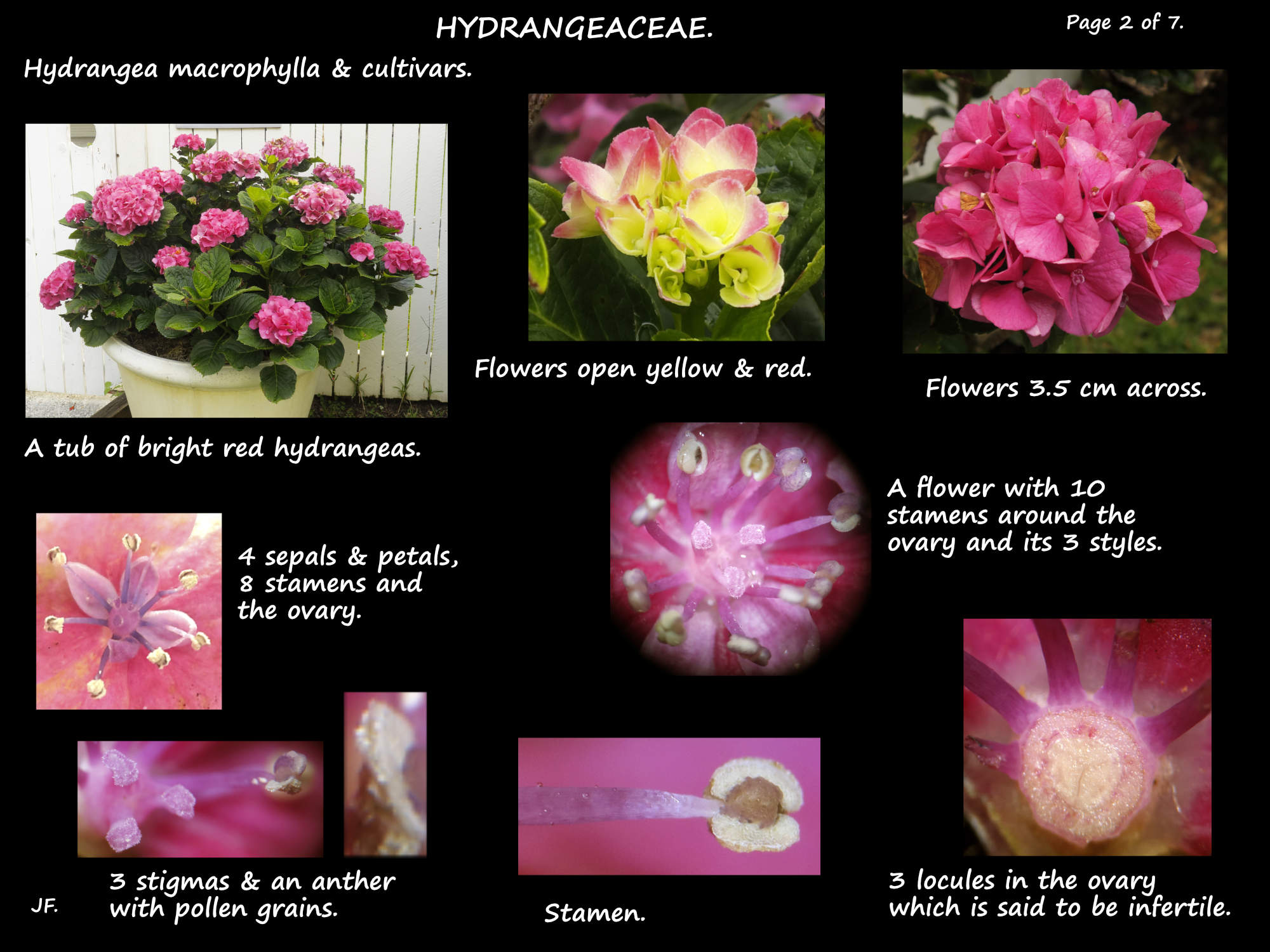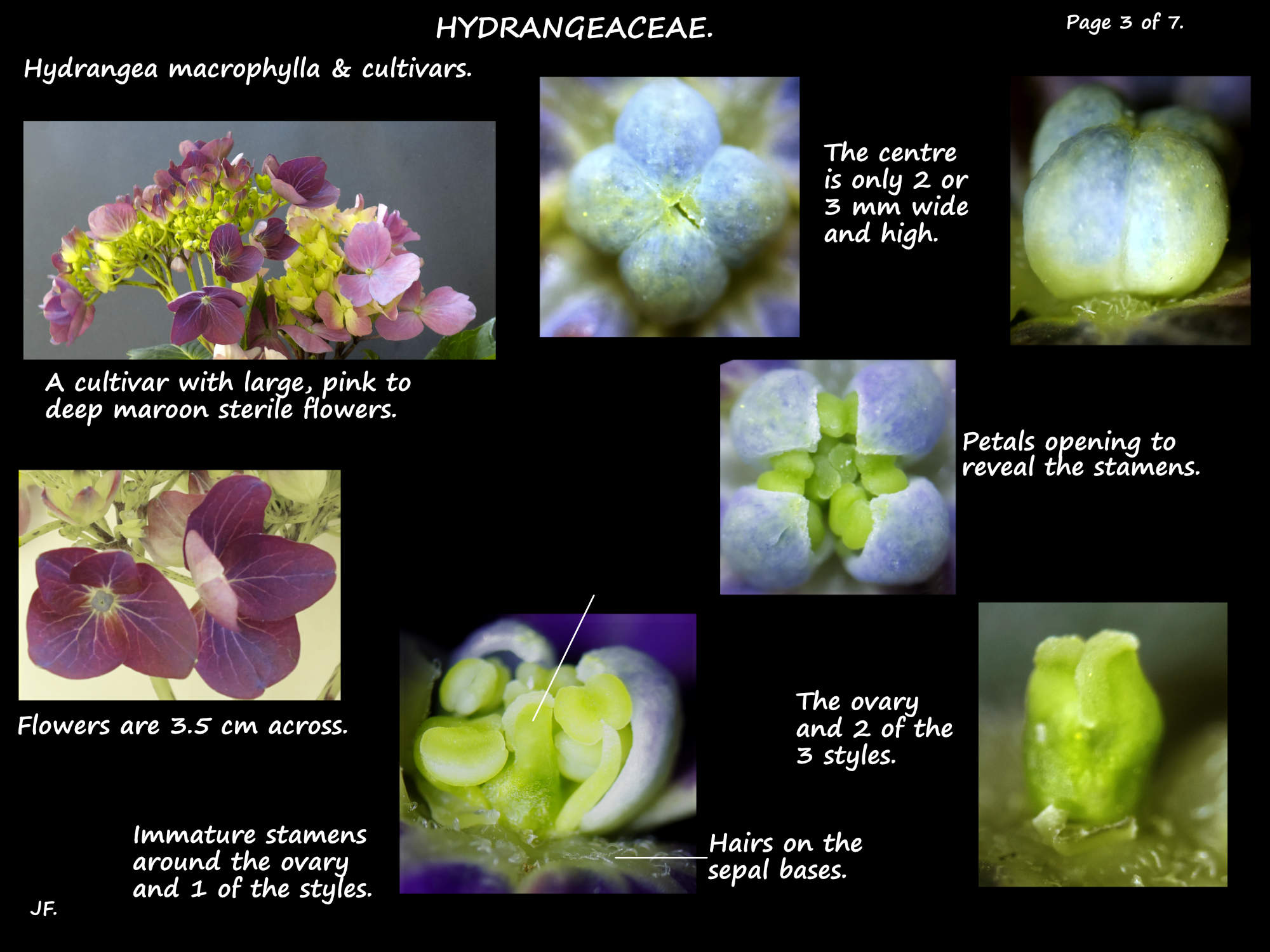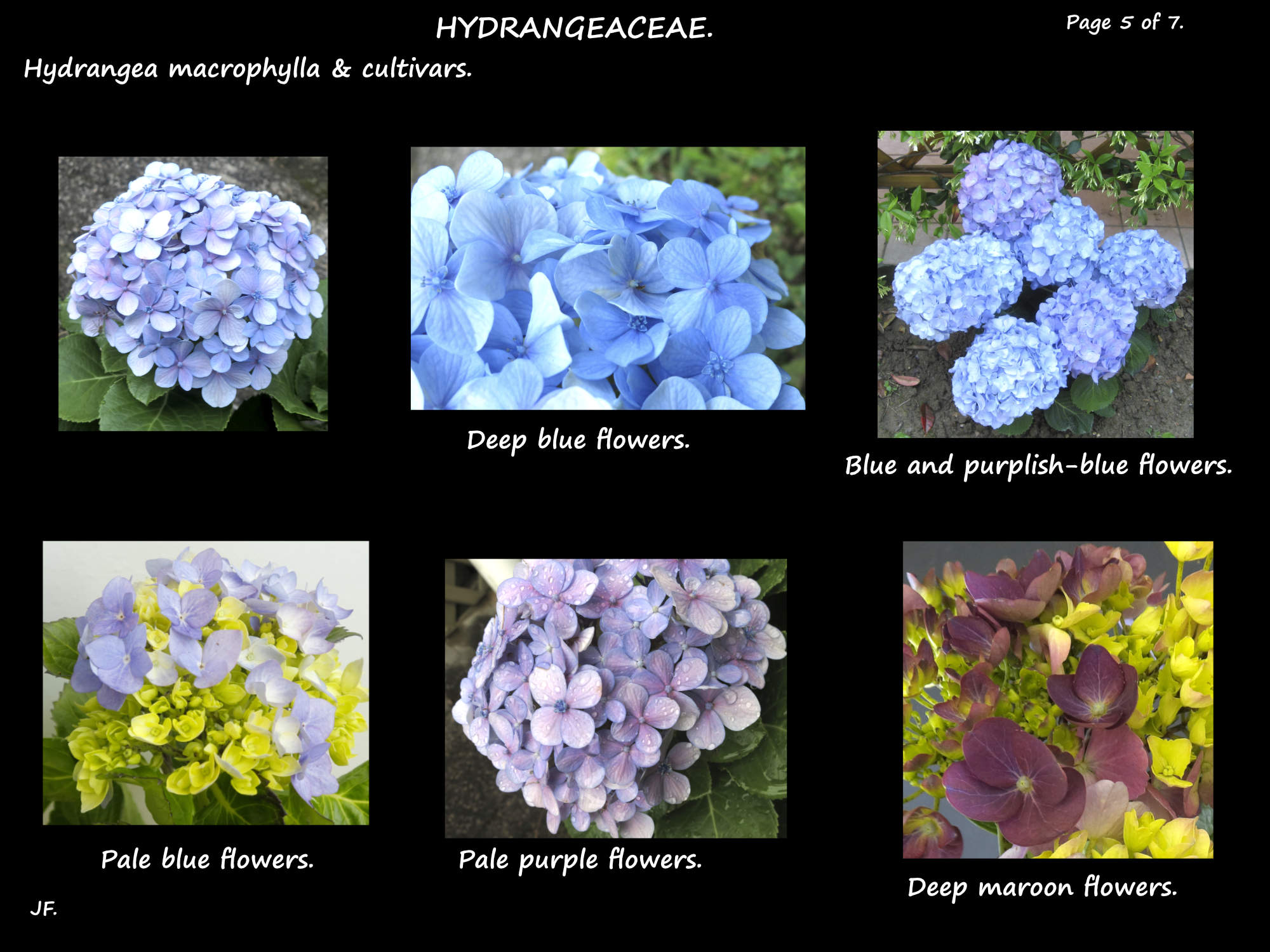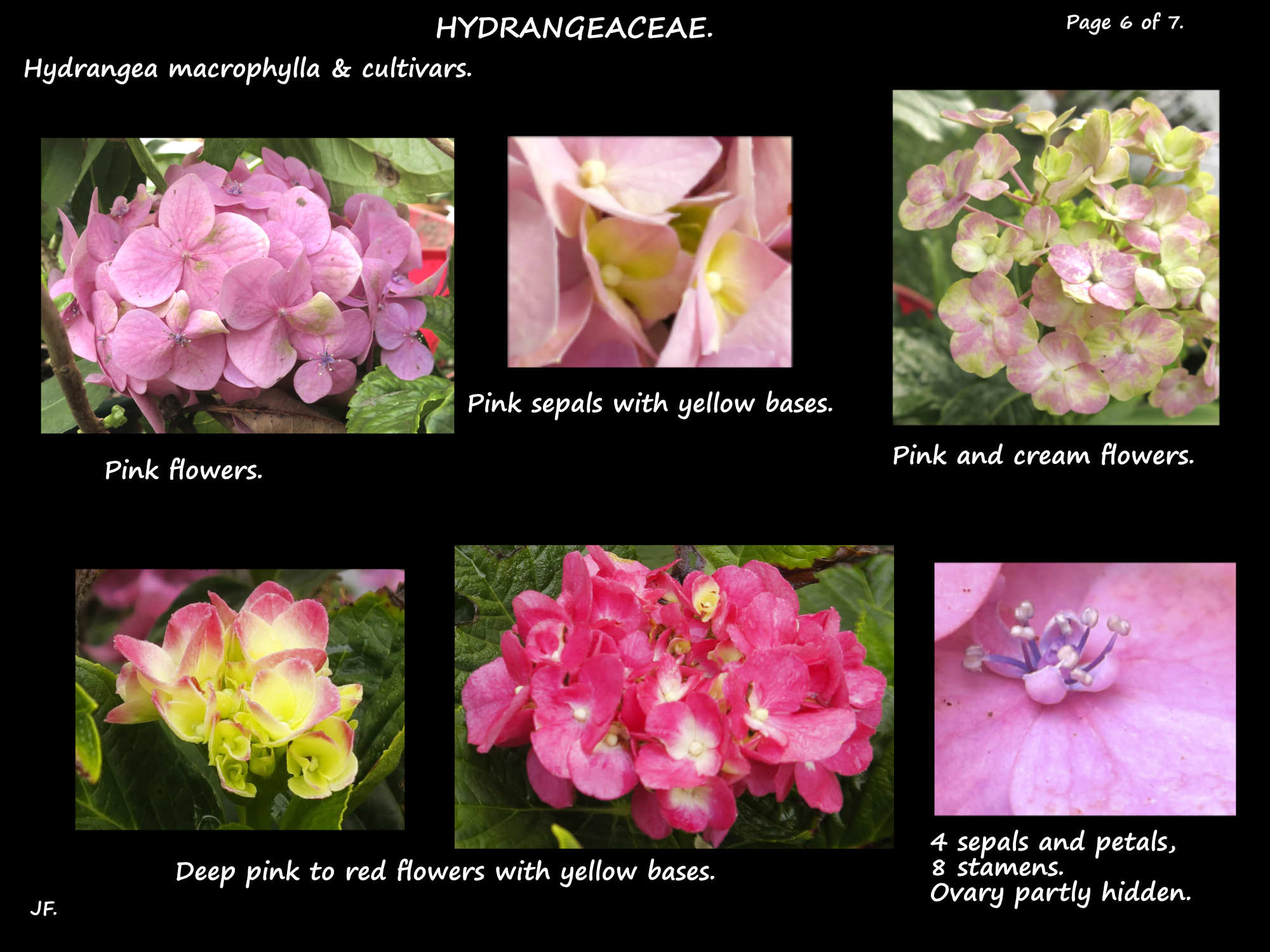Hydrangea macrophylla & its cultivars.
Bigleaf Hydrangeas are also known as florists’ hydrangea or hortensia.
Hydrangea hortensia is a synonym.
They are native to an area extending from the Himalayas to China, Korea and Japan.
Due to the wide range there are variations in their features that are reflected in the subspecies.
A few species, and the huge range of cultivars are used extensively as ornamentals and cut flowers.
H. macrophylla are dense, deciduous shrubs up to 3 m high and almost as wide.
The older woody stems are brown and the new ones are green with prominent dark lenticles.
Younger branches may be smooth or have curled hairs lying close to the surface.
The simple, opposite leaves, up to 20 cm long and 13 cm wide, are on petioles up to 4 cm long.
The blade is widely ovate to elliptic with a pointed tip and coarse teeth on the edge.
The upper surface is a shiny green to dark green and the paler lower surface has prominent veins.
There are no hairs on the upper surface but young leaves may have a few on the lower surface.
When leaves fall a heart-shaped scar is left on the stem.
Classification.
Bigleaf hydrangeas and their subspecies, forms, cultivars etc. can be classified by:
1. Botanical name:
Hydrangea macrophylla.
Hydrangea macrophylla subsp. serrata (sometimes seen as a species H. serrata).
Hydrangea macrophylla var. normalis.
These are the ones most commonly seen.
Hydrangea macrophylla var. otaksa is the third subspecies.
2. Inflorescence type – Mophead, lacecap or conical.
H. macrophylla inflorescences are corymb-like (a corymb is an inflorescence with a flat or slightly
rounded topped with the lower pedicels being longer than the upper ones).
They have a mix of small fertile flowers in the centre with larger sterile ones at the edge.
These are Hydrangea macrophylla var. normalis.
Cultivars have been bred mainly to increase the number of the larger sterile flowers.
Many of these cultivars have large spherical flowerheads and are known as Mopheads.
They may have few or no sterile florets.
Those with flatter inflorescences and fewer sterile flowers that are sometime in a complete or partial
ring around the fertile ones are the Lacecaps.
Most of the H. macrophylla var. serrata cultivars are lacecaps.
H. macrophylla and H. macrophylla subsp. serrata are both used as ornamentals while the former is
grown for the cut flower trade.
H. macrophylla var. serrate is a smaller shrub with thinner stems and smaller leaves and inflorescences.
Hydrangea paniculata has cone-shaped inflorescences.
The much-branched terminal inflorescences can be on new or old wood.
Flowers are usually densely packed and are of two types – sterile and fertile.
Sterile flowers or florets. #
These lie at the edge of the inflorescence and may be few to many.
They have (3) 4 enlarged petal-like sepals, fertile stamens and a sterile ovary#.
Up to 3 cm across they can be white or a bluish-pink.
They may be a different colour to the fertile flowers.
Fertile flowers.
These much smaller flowers are central in the inflorescence.
They have a hypanthium up to 5 mm long, 5 sepals and 5 deciduous petals.
As noted in the Hydrangea text file H. macrophylla contains anthocyanin pigment so the colour of the flowers can
be changed between blues, mauves and pinks or reds by altering the acidity and aluminium content of the soil.
There are 10 stamens up to 6 mm long with filaments that are initially free but as the flower matures
the bases become fused for up to 1 mm.
The ovary starts out inferior but as the flower grows and matures it changes to being half superior.
There are 3 styles (2 to 5) only 1 to 2 mm long.
The brown almost spherical capsules are under 1 cm long and have 2 to 5 locules.
They open via apical pore/s between the bases of the styles.
There are numerous pale brown seeds in each locule.
Cultivars.
There are over 1000 named Bigleaf cultivars.
There may be the usual 5 tepals but some cultivars have many more than this including some doubles.
Tepals can be up to 2 cm long with entire, toothed, wavy, scalloped or frilled edges.
They come in many shades of blue, pink and purple plus white or light green.
Descriptions include pale, mid, medium or deep blue, Ice-blue, Cambridge blue and Intense deep blue;
deep, dark, rose or cherry pink, vivid or rosy crimson, brilliant, dark, brick or rose red;
and light or dark purple, mauve, purplish, lilac, violet and deep purple-blue.
One cultivar has red tepals with a bright green edge; others are white with red or blue margins or red with a cream edge.
There are also some with variegated leaves having cream, yellow, or darker green colourings or a white edge.
Note # Perianth in sterile flowers.
The genus description of Hydrangeaceae from Delta-Intkey has:
“Hydrangeaceae Dum.
Perianth with distinct calyx and corolla; 8-24; 2 whorled; isomerous.
Calyx 4-5(-10); 1 whorled;gamosepalous (usually); regular (except in outer,sterile flowers when these present);
Corolla 4-5(-10); 1 whorled; polypetalous; regular.”
Most descriptions of the sterile flowers mention only 1 perianth whorl, (the enlarged sepals) and make no mention
of the inner whorl. Some refer to the sepals as bracts.
The sterile ray flowers I have seen have what appear to be 2 perianth whorls.
Reproductive parts of sterile flowers.
Most descriptions of the sterile flowers say that they have no stamens or ovary.
The Wikipedia description of Hydrangea macrophylla has:
“Two distinct types of flowers can be identified: central, non-ornamental, pentamerous ones, and peripheral, ornamental,
tetramerous ones. The latter have sterile pistils with fertile stamen. The four sepals of decorative flowers have colors ranging
from pale pink to red fuchsia purple to blue. The non-decorative flowers have five small greenish sepals and five small petals.”
Another description says the sterile flowers are unisexual, staminate flowers.
The sterile ray flowers I have seen are as described in Wikipedia.
J.F.









